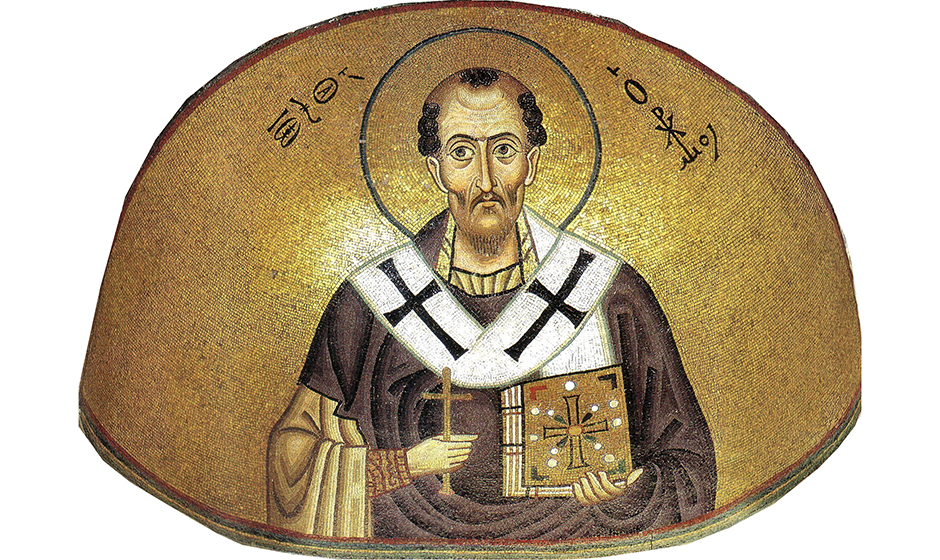GREAT PREACHERS AND THEIR PREACHING: JOHN CHRYSOSTOM
The following article is part of a series of articles that will traverse church history to examine the preaching of great preachers.
Most of us will never be considered such great orators that we are given a nickname that means “Golden Mouth.”
Chrysostom (c. 347-407 AD) was trained at the feet of the famed orator, Libanius. Though formal training likely helped Chrysostom in his preaching ability, it was his consistent labor in being a student of Scripture and his discipline of communicating on the level of his hearers that led to him be one of the greatest preachers in history.
Stenographers said that John was so persuasive in his preaching that, after denouncing people for their excesses, they would return the following day to hear John continue to preach. John would often interrupt the applause of his listeners to warn them about robbing Christ of his glory through their applause of a mere man. What was it about John’s preaching that endeared him to all of Constantinople and into church history?
Masterful Use of Illustrations
First, Chrysostom was a master at the use of illustrations. Walter MacGilvray wrote that, to Chrysostom, “no flower bloomed, no bird gave out its morning or evening song, no insect of day, no cloud that crossed the sky was meaningless.”[1]
Though he was formally trained in rhetoric and Greek philosophy, John was intent to keep the language of his sermons on the level of the people to whom he was preaching. He consciously avoided the language of academics. He was able to communicate deep truths with simple analogies. He would speak in the language of “farmers and seafarers.”[2]
The content of John’s sermons was such that the novice could understand them but were deep enough so that everyone felt they had grown in the knowledge of God having listened to Chrysostom. He writes, “I treat so many things in each of my sermons and make them so varied because I want everybody to find something special for himself in it and not go home empty-handed.”[3] For John, one of the best ways to develop depth in the message while also maintaining truths that were manageable for the new believer was through the skillful use of illustrations.
Careful and Consistent Exegesis
Though John made great use of illustrations, he avoided fanciful interpretations of Scripture. John fit nicely into the Antiochian school of exegesis, which sought to be faithful to the text of Scripture rather than drift into allegorical interpretations that often defined the Alexandrian school.
John believed that God had been precise in the giving of Scripture, therefore the preacher should be precise in the way that he handles the text. He typically divided the text into smaller pieces that would allow the hearers to remember the exposition in relationship to the text which he was preaching.[4]
John also recognized that the greatest way to lead people to a deeper knowledge of God was to reflect deeply upon the text while pointing them to see God through Scripture. When preaching through Romans, one biographer said that John desired for his congregation to develop a “deeper acquaintance with Paul.” Though he engaged in textual, linguistic and historical information, he had an “anthropological passion” that was God-centered.[5]
Clear Appeal to Action
John seemed to be aware that the flowery use of language in rhetoric, though enjoyable to his hearers, could threaten the clarity of the message. In order to balance his oratorical ability, John was intent to include a clear appeal to action. His intent was to urge sinners to repent and to confess their sins. William Stevens, a biographer of Chrysostom, writes that his greatest ambition was to “convert souls.”[6]
The desire to see the conversion of souls and the development of Christian virtues is what led John to include doctrine, illustration, and practical application in his sermons.
Though he desired to provide clear points of application, he knew that the faithfulness of the preacher was not judged by the immediate response of the audience. Rather, John looked to the ongoing effects that the consistent preaching of God’s word had on people over time.
He also knew that that one of the greatest threats to the effectiveness of the preached word is the pride of the preacher. He said the only applause that he sought was the applause of good deeds as his hearers responded to his preaching with lives that reflected God’s Word.[7]
A Tenacious Pursuit of God’s Glory
Along with illustrations, careful and consistent exegesis, and a clear appeal to action, one final lesson that we can learn from Chrysostom is tenacity. John faced plenty of opposition during his ministry. He was known to preach against the excesses of the day, including the empress, Eudoxia.
Eudoxia responded by seeking to banish Chrysostom from the region. When many preachers before had compromised due to the threats of various officials, John was unwilling to forsake what he believed to be his highest calling. He also refused to be discouraged when preaching God’s Word was not having the desired effect:
He to whom the office of preaching is entrusted should not desist from preaching, no matter whether he has success or not. If he converts only ten or five or even only a single one, should not that suffice to make him happy? Indeed, if he converts none at all, which seems to be an impossible case, it would still be a gain, if men would sin with somewhat less boldness and effrontery; and anyhow the reward for his trouble remains sage for him. For we are not obliged to convert the people, but only to admonish them to be converted.[8]
Though John remained faithful, Eudoxia did not relent. Eventually, John was banished from the city to a small mountain village in Armenia and then to the edge of the Black Sea. While being taken to the Black Sea, John requested to enter a small chapel. After worshiping in the chapel, he succumbed to the cruel winter and died at the age of sixty. His final recorded words were “Glory to God in all things, amen.”[9]
We can learn from John Chrysostom that, through the masterful use of illustrations, careful and consistent exegesis, clear appeals to action, and a tenacious pursuit of God’s glory, the preacher can rest in the knowledge that he has honored God as he seeks to remain faithful to God’s calling.
[1] Walter MacGilvray, John of the Golden Mouth (London: James Nisbet and Company, 1871), 352.
[2] J.N.D. Kelly, Goldenmouth: The Story of John Chrysostom – Ascetic, Preacher, Bishop (Ithaca, NY: Cornell University, 1995), 60.
[3] Donald Attwater, St. John Chrysostom: Pastor and Preacher (Toronto: Harvill Press, 1959), 33.
[4] Robert C. Hill, “St. John Chrysostom: Preacher on the Old Testament,” Greek Orthodox Theological Review 46, no. 3 (2001): 273.
[5] Demetrius Trakatellis, “Being Transformed: Chrysostom’s Exegesis of the Epistle to the Romans,” Greek Orthodox Theological Review 36, no. 3-4 (1991): 212.
[6] William Stephens, Saint John Chrysostom: His Life and Times (London: John Murray, 1883), 422.
[7] John Chrysostom, “Prolegomena,” in The Nicene and Post-Nicene Fathers, ed. Philip Schaff (Grand Rapids: T&T Clark, 1996), 22.
[8] Chrysostomaus Baur, John Chrysostom and His Time, trans. M. Gonzaga, vol. 1 (London: Sands and Company, 1959), 209.
[9] Chrysostom, Prolegomena, 16.
John Mann serves as Associate Professor of Business and Theology, and Assistant to the President for Constituent Relations at Southwestern Baptist Theological Seminary.



